#veg chutney
Explore tagged Tumblr posts
Text
Delicious and Healthy: Explore Vegetarian Appetizers at Mango Grove
Our veg appetizers with mint chutney and tamarind chutney is designed to offer a burst of flavor with every bite. Whether you prefer something crispy and fried or light and refreshing, there’s an option for every palate. Plus, all our appetizers are served with fresh mint chutney, adding a delightful touch of freshness to each dish.
0 notes
Text
Moong Dal Chilla (Puda/Pudla) with Green Chutney
Moong Dal Chilla(Puda/Pudla) with Green Chutney Moong Dal Chilla is also known as Puda /Pudla. These savoury Moong dal Pudlas are delicious earthy, nutty, savoury buttery crepes, They are so easy and quick to make and are a great replacement for rotis or paratha. Chillas are healthy and delicious and keep your tummy full. Moong Dal Chilla (Puda/Pudla) can be made with or without vegetables and a…

View On WordPress
#Easy Indian Snacks#Easy Recipes#Gluten-Free Chilla Recipe#Healthy Moong Dal Chilla#healthy recipes#High Protein Vegetarian Recipes#Homemade Moong Dal Chilla#How to Make Moong Dal Chilla#Indian Breakfast Recipes#Indian Pancake Recipes#Indian Street Food Recipes#Low-Calorie Indian Snacks#Moong Dal Chilla and Chutney#Moong Dal Chilla Recipe#Moong Dal Chilla with Green Chutney#Moong Dal Pancake Recipe#Moong Dal Recipes Green Chutney Recipe#Protein-Rich Breakfast Recipes#Quick and Healthy Breakfast Ideas#Quick Recipes#spicy veg recipes#step by step#Traditional Indian recipes#veg recipes#Vegan Moong Dal Chilla
1 note
·
View note
Text
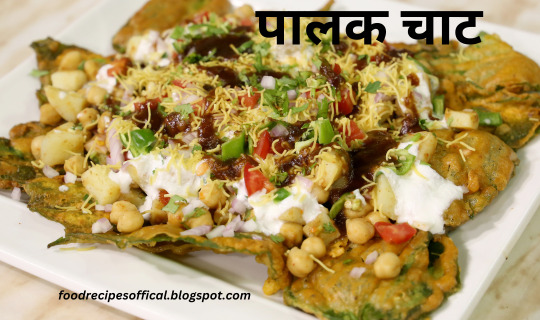
Spinach Chaat. As a medicine, spinach is used to treat stomach and intestinal (gastrointestinal, GI) complaints and fatigue. It is also used as a blood builder and appetite enhancer. Read full recipe https://foodrecipesoffical.blogspot.com/2023/11/470-healthy-food-recipe-spinach-chaat.html… http://foodrecipesoffical.blogspot.com
#Sabudana Vada#Paneer Pinwheels#Almond Pudding#“Paan Pumpkin Cream.”#"Potato Jalebi#Pan-fried chickpea#Chicken Shashlik Sizzler#Methi Corn Pulao#Methi Matar Malai#Dum's Arvi#Chhuara Badam Halwa#Almond Chips#Nankhatai. Chocolate Gujhiya#Paneer Makhani#Moong Dal Dhokla#Veg Hot Dogs#Soan Papdi Milkshake:#Spiral Potato#Tamarind and Date Chutney#Jain version of Veg Kolhapuri#Garlic-Red Chilli Chutney#Potato-Pea Khichdi#Elevated Egg Toast Delight#Spinach Chaat
0 notes
Text
Lunch Plate - Jun 5 2023
Plantain Stem kootu, yam poriyal, papad, mint chutney, mango. An all vegan lunch.. delicious Also in the blog now: Lunch Plate – Jun 5 2023Easy Nutella BrowniesJuicing leftover fruits and vegetablesArbi Fry Recipe – story post Check out my Instagram profile and highlights for more pics and recipes – @Fhareena #parveenskitchen #foodblogger

View On WordPress
#Easy recipes#Healthy#Indian recipes#Lunch plate#Mango#Mint Chutney#papad#Plantain Stem kootu#veg#veg lunch#yam poriyal
0 notes
Text
Mix veg sandwich: Try this recipe of this perfect lunch platter
Try this recipe of mix veg sandwich
Mix veg sandwich are one of the most delicious sandwiches. You can eat this delicious mix veg sandwich which act as a divine eating. It is one of the succelent eating which is tempting. This sandwich add a delight to your taste and can make you agreed with all thef food critics. It’s especially for all those who want to eat healthy. This sandwich is full of fiber with the flavours of vegetables…
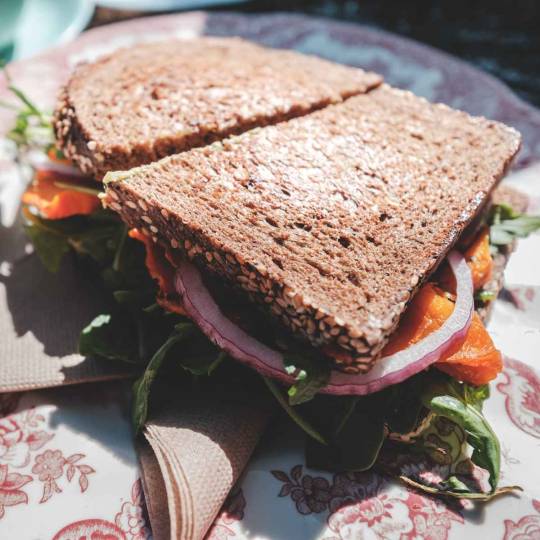
View On WordPress
#bombay sandwich#bread#butter#chaat masala#cheddar cheese#chutney#cilantro#coriander#cucumber#food#Health#lean protein#Lifestyle#mix veg sandwich#nutritional facts#seasonings#spices#vegetables#veggies
1 note
·
View note
Note
Excuse me could we get some farmtale sans headcanon please just a crumb
You don't need to ask twice lol
He's deceptively strong, even by Sans standards. He's on par with Skull for raw strength. This guy carries massive heavy things pretty much for a living; he loads bales bigger than you. He could carry you around on one arm, and he might genuinely tuck you under one arm if he needs to carry you while he's busy
However he is also extremely Somft. He simply wants to sit on the couch and wear chunky knit sweaters and drink soup all day.
His greatest talent is coming up with places to nap that are out of sight of Papyrus. You'll be regularly tripping over him
He's wonderful to nap with! He smells like straw and sweet veg, his strong arms are perfect for cuddles. He is unreasonably comfy.
He flirts by giving you things from the farm. He'll show up to your door without warning, carrying cartons of fresh eggs, boxes full of veg, butters and jams and chutneys... one time, even a whole wheel of cheese.
(Probably saves you hundreds on groceries.)
Papyrus frequently asks you to go check on Sans while he's working, maybe to bring him food or a drink, 'see if he's doing it right', etc. Papyrus knows Sans is absolutely fine and knows how to do those jobs. But he also knows that Sans makes an art out of half-assing certain chores and making them take forever... if you're there, Sans wants to show off, and he ends up working twice as fast.
Sans has a way with animals. His vibes are just so easygoing that even the most high-strung creatures like him. Anytime he falls asleep, he ends up with chickens sitting with/on him until he wakes up.
For a guy who works with plants, he's pretty terrible at remembering the names of them. He knows the important ones, and that's about it. Don't expect him to remember more than he absolutely has to.
He's an excellent seamster! If anything you like rips, let him know. He can make it look good as new.
His love language is acts of service. He does the absolute bare minimum for people he doesn't like, and equally, he does So Much for people he loves (like you). He'll tow you for miles if you break down, he'll pick you up from anywhere at any time without complaint, he'll lend you incredibly important items of his as if it's no big deal. If you leave him alone in your home for too long he'll find something to repair or tweak... clothes, furniture, holes in the walls/creaky windows, etc. You'll come downstairs in the morning to find out he's fixed your heating.
His ideal date is driving out to a quiet field at night, then sitting under a blanket together and watching the stars. He may not know his plants... but he knows his stars, that's for sure.
Too bad he'll be too busy looking at you.
821 notes
·
View notes
Text
I made these as a starter this evening and they were really good. Super simple, quick, cheap to make and they’re good hot or cold. I had some mango chutney with mine - would recommend!
16 notes
·
View notes
Note
I know this isn't a writing ask, but I wanna ask about hosting/entertaining. When it comes to budgeting and that in regards to those events is there any tips/tricks you have to doing it so that you don't spend too too much money? Like hosting a potluck would be an example, but do you have any others? I really want to host/entertain when my living situation is more viable to that, so I'm wondering what sort of tips you have.
So, my partner and I do do a lot of cooking anyway, and we're generally decent at doing decent batches of stuff at once where we can.
The plan for this party is like, BYOB and bring a dish if people would like.
Because a lot of the people we know have various dietary restrictions - veganism and vegetarianism, various allergies and intolerances, autism food things - the plan is to have a few dishes out for people to choose from.
Oven pizzas are nice and easy and also very cheap, especially because we're very near to LIDL and ALDI respectively, and it's generally pretty easy to like, grab cheese pizzas and then add on toppings as desired in terms of fresh vegetables.
I'm thinking that unless my partner wants to do a chilli, I'll probably do a rabbit stew, which is pretty cheap - red wine, a rabbit (normally like £5 from the butcher's), potatoes, onions, root veg like carrot or parsnips, oregano, garlic, and you're good to go. It's just in the slow cooker, so it doesn't take a lot of time.
Rice in the rice cooker is easy to do and fairly cheap, so we'll probably pop it on and then have the slow cooker and the rice cooker both available on the table.
A roughly Greek-style salad - for this size, will probably be two cucumbers, a packet of cherry tomatoes, a red onion, a packet of feta-style salad cheese, spinach, possibly a yellow pepper, garlic granules, oregano, lemon juice, and olive oil.
Probably going to do a fresh foccacia, because I know it's an easy safe food for a friend who has a bunch of allergies but not wheat or gluten, and fresh bread is pretty cheap to do, especially because I already have the yeast and bread flour.
And then I was thinking I might also bake some other stuff - I have a pastry scroll I regularly do which is tomato purée or some sort of chutney with cheese and bits of bacon or pepper, rolled up and then baked as individual scrolls with the filling; maybe some kind of potato cake because we'll have potatoes on hand; other than that, maybe some kind of sugar cookie or an easy tray-bake like a brownie or something.
The majority of the dishes I'm describing use a lot of the same ingredients, and these are dishes we cook regularly, so they're not generally tough to do. I'm expecting to be spending extra on this party than I ordinarily would on groceries, but because it's just the same sort of dishes and foods we normally make, it's just doing them a bit bigger, if that makes sense? I'm not really worried about additional cost.
15 notes
·
View notes
Note
Cooking as a listed interest? Ooh, any go to meals that you wanna share? :3
Absolutely!! :3
Low effort meal is pressure cooker risotto. The following makes about 3 meals worth for me.
Rinse 200g of arborio rice until the water runs clear, then dump it in the pressure cooker pot. Add 750ml of liquid. Usually this is just stock, although it's nice to put in a glug or two of wine. I'm aware this might look like a lot, but it's the right ratio, you gotta trust me :3
Put this on to pressure-cook for 7 minutes. I use my pressure cooker's high setting for this, so use your equivalent. Then, I let the steam release naturally for 10 minutes, before venting off the rest manually.
Open the lid once it's safe, and give it a good stir and mix, before placing the lid back on and letting it sit for 5 minutes, and then it's done!
Taste and adjust seasonings as necessary. Adding in fried mushrooms or powdered parmesan is really nice. It's a low effort meal and very good for it, though eating a full plain bowl of it can lead to it getting boring by the end, so little additions go a long way.
This is only low effort because of the pressure cooking, you can make this dish otherwise but it's not simple and requires a lot of time and attention 😅
Medium effort meal is slow cooker lentil dahl. The following makes about 3 meals worth for me.
Take split red lentils, and rinse them in water repeatedly until the water runs clear, like rice. I'd say maybe about half a bag, 250g? Depends how much you'd like to make but the ratios of ingredients are flexible.
Dump this into the slow cooker pot, and add a tin of chopped tomatoes. Slice up some veg of choice at a medium dice, and put that straight in too. Bell peppers, carrots and onions work particularly well. One large carrot, a bell pepper and an onion is a good amount, for reference. Then, add one thingy of stock in whatever form you like (stock cube, stock pot, etc.) mixing it with water to start breaking it up. Add seasonings (a good pinch of salt, and I usually go for a decent sprinkle of curry powder and a small sprinkle of paprika). Then, add water until it covers all the lentils and veg.
Turn the slow cooker onto high with the lid on for about 2-3 hours. Then give it a mix, make sure nothing is burning or stuck to the bottom, then set it on low with the lid on for a couple hours or until it starts looking really good. If you check and it looks dry, add water and make sure it's not burning on the bottom again. If it looks too wet, leave it on low with the lid off for an hour or so.
Taste and adjust seasonings as necessary, then serve up! It benefits quite a bit from little toppings, like yoghurt, mango chutney or crispy fried onions/garlic.
If you don't have a slow cooker, you should be able to do this with a pot on the stove, but you'd have to figure out how to adapt the temperature and all that.
High effort meal is homemade pizza! It's fun because people can make their own once you've made the basic pizza.
Basically I've poached this recipe from BBC Good Food, see here:
I have some notes for this though, so it's not all poached :3
Ignore the request for fancy italian flour, just use plain flour and it'll be fine. Pick the toppings you want, too.
Be careful with the temperature it recommends. Hottest is best for pizzas, I agree, but you definitely need to keep an eye on it for anything like 270°C, because it will just burn if you let it.
Since most of the time I'm making this for several people, and all the pizzas don't tend to fit in the oven at the same time, once you've got the little balls finished you might need to do them in batches.
You can prepare the pizzas in advance by cooking as the recipe says and doing tomato sauce plus mozzarella/cheddar topping to make a cooked Margarita pizza, and then leaving it until it's time to eat. Then, have each person choose a pizza, and top it with whatever additional toppings they'd like, then put it in the oven just to warm up and cook the toppings. Not 270°C for that though, just go for 200°C for about 10mins, or until it looks done.
#asked and answered#cooking#i have a multi cooker that i got as a gift which can pressure cook and slow cook and it's really nice :3
10 notes
·
View notes
Text
Discover the Delicious World of Vezlay Vegan Food and Products
Introduction to Vezlay Vegan Delights
Vegan food has become a global trend, with health-conscious individuals and animal lovers opting for plant-based diets. Vezlay Foods has emerged as a trusted name in this space, offering an array of vegan products designed to satisfy diverse tastes. Let's dive into the variety and benefits of Vezlay vegan foods.
What Makes Vezlay Vegan Products Unique?
Vezlay stands out by providing innovative vegan alternatives to popular dishes. Their focus on taste and nutrition ensures that every product delights the palate while supporting a healthy lifestyle. Here are some standout features:
High-Quality Ingredients: Vezlay uses premium plant-based ingredients that are rich in nutrients.
Diverse Range: From vegan kebabs to soya chaap, their products cater to various cuisines.
Environment-Friendly: Vezlay promotes sustainability with eco-conscious manufacturing practices.
Top Vezlay Vegan Products to Try
Soya Chaap: Soya chaap is a versatile product, perfect for curries, grills, or stir-fries. It's protein-packed and mimics the texture of meat, making it ideal for transitioning vegans.
Seekh Kabab: These Seekh kabab are a flavorful addition to parties or quick snacks. They're spiced perfectly to suit both Indian and international taste preferences.
Veg Meat: Vezlay's veg meat options are crafted to replicate the taste and feel of traditional meat. Use them in burgers, wraps, or as standalone dishes.
Shami Kabab: Rich in spices and easy to prepare, Vezlay's vegan shami kabab are a must-try for those craving hearty snacks.
Health Benefits of Choosing Vezlay Vegan Foods
Switching to Vezlay vegan products offers numerous health advantages:
Improved Digestion: Plant-based foods are rich in fiber, aiding digestion.
Lower Cholesterol: Vegan diets help reduce bad cholesterol levels, supporting heart health.
Weight Management: Their low-calorie, high-protein content helps maintain a healthy weight.
Rich in Nutrients: Vezlay products are fortified with essential vitamins and minerals.
How to Cook with Vezlay Products
Incorporating Vezlay products into your meals is effortless. Here are some ideas:
Soya Chaap Curry: Marinate soya chaap in spices, then cook it in a rich tomato-based gravy.
Grilled Kebabs: Simply grill the vegan kebabs and serve with a tangy mint chutney.
Wraps and Rolls: Use veg meat slices in wraps with fresh veggies and sauces for a quick meal.
Why Choose Vezlay for Your Vegan Journey?
Vezlay combines innovation, health, and taste, making them a preferred choice for vegan enthusiasts. Their commitment to quality and sustainability resonates with consumers looking to make ethical and nutritious food choices.
Conclusion
Vezlay vegan products are more than just food; they're a lifestyle choice that benefits your health and the planet. Whether you're a seasoned vegan or just starting your plant-based journey, Vezlay offers something for everyone. Explore their range today and transform your meals into delightful culinary experiences.
#vegan#food#foodporn#veganfood#healthcare#dessert#foodie#dinner#delicious#cooking#health & fitness#soyachunks#recipes#vegan recipes#plant based#vegan food#spices#dark chocolate
14 notes
·
View notes
Text
Dinner Recipe: Salmon and Vegetables

TIME: ★★★✰
PRICE: ★★✰✰
EASE: ★★★✰
CLEANUP: ★★★✰
There is a WIDE scope to salmon and veg recipes. Salmon, at least where we are, is a little on the pricier side, but we love it and the doc said it was good for our eyes so we ran with that as an excuse, LOL!
We are constantly looking for a variety of ways to cook and dress salmon. I believe these recipes would generally work for both frozen and fresh fillets, with some minor modifying.
It's a super quick thing to serve these with a handful of salad greens, but our go-to is broccoli! I made a short blurb on how we like to prepare broccoli in a tasty way! The different recipes could range between 20-40 minutes, depending on which one you're making!
Cast Iron Salmon (DishNTheKitchen)

Crispy Honey Orange Glaze Salmon (CafeDelights)
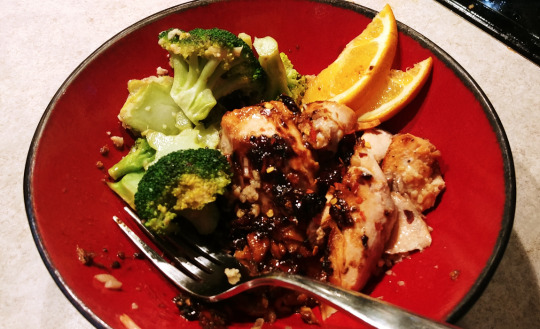
Salmon with Apple Fig Chutney (WhatJewWannaEat)
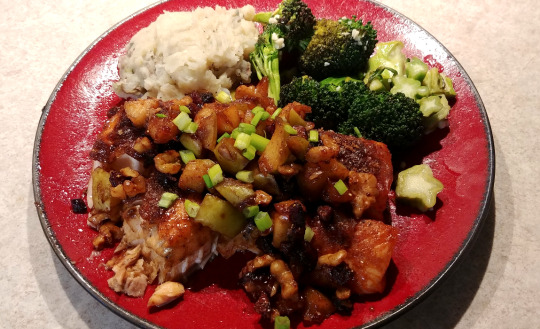
Lemon Basil Pesto Salmon (JarOfLemons)
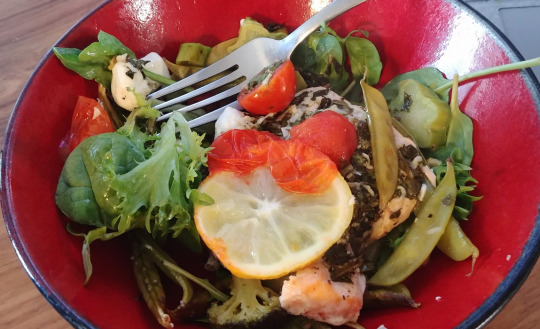
I don't have photos of these recipes but I have made them and they're very tasty!
Brown Sugar Soysauce Salmon (Key to My Lime) This is one of our go-to salmon recipes! Very classic and tasty!
Parmesean Crusted Salmon (Cooking Classy) Recently made this and it was a really nice change of pace with texture and flavor! Highly recommend it if you like parm!
We also enjoy making Salmon Bowls. Just dig up some veg we have lying around and serve it with salmon over rice. Below we had avocados, mukimame, cucumbers,carrots, and mandarin oranges over rice with some orange glaze salmon!

28 notes
·
View notes
Photo
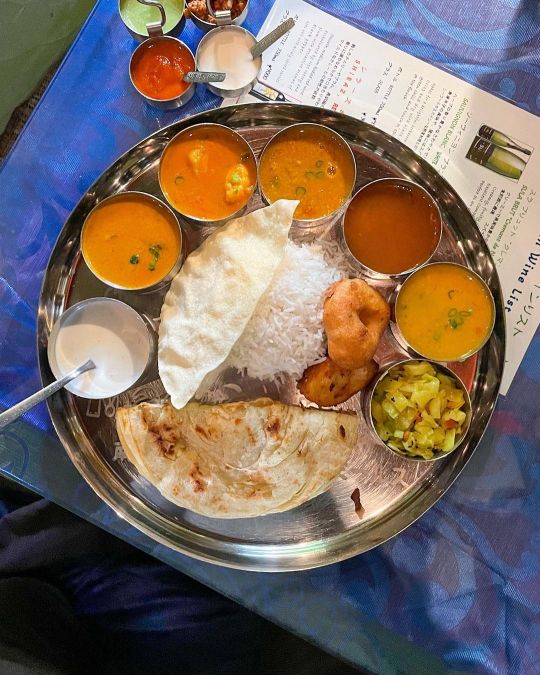
【3714日目】2023-03-19 去年の今日ちょうど1年振り。息子の成長を伝えに第二の故郷へ。 Madras Meals マドラスミールス@新丸子 ____________________________________ *Mutton Kheema Biryani Onion Pachadi Chicken Curry Payasam *Special Meals Veg Curry Chicken Curry Sambar Rasam Kootu Poriyal Medu Vadai Spicy Fried Chicken Appalam Basmati Rice Parotta Payasam Tea *Chutney -tomato chutney -coconut chutney -green chutney -ginger chutney *Kids Dosai *Lassi *Tea 今週のWEEKEND SPECIALは、マトンキーマビリヤニ。ベンガル地方のビリヤニだと思っていたのですが、タミル式でもいただけるなんてラッキー。 均等に炊き込まれたフワパラ食感のライスと、弾力のある力強い羊肉が、まだらに混ざるのがおいしさの秘訣。うまいうまい。 ミールス…やはりこの店のサンバルは特別。妻も同じことを考えていたようで、嬉しい気持ちになりました。豆の風味も絶妙で、シンプルで深い。 爽快感のあるすっきりラッサムも美味。ヒーングをたっぷり効かせたポリヤルもマドラスミールスならではの味なのだ。 僕の南インド料理好きを育ててくれた大切なお店。ずっとこの料理が変わらないことが嬉しくて、またお邪魔することでしょう。 ____________________________________ 🇮🇳 #south #india #indianfoods #asianfood #asia #foodpic #foodstagram #tasty #Tamil #Madras #meals #seefood #spice #curry #インド #マドラスミールス #タミル #武蔵小杉 #新丸子 #カレー #毎日カレー #カレー好きな人と繋がりたい #フクドローン #ふくすたぐらむ #ミャンマーからきたみゃんちゃん の誕生日でした ↓Madras Meals @madrasmeals (マドラスミールス madras meals) https://www.instagram.com/p/CqdHrv-SCrj/?igshid=NGJjMDIxMWI=
#south#india#indianfoods#asianfood#asia#foodpic#foodstagram#tasty#tamil#madras#meals#seefood#spice#curry#インド#マドラスミールス#タミル#武蔵小杉#新丸子#カレー#毎日カレー#カレー好きな人と繋がりたい#フクドローン#ふくすたぐらむ#ミャンマーからきたみゃんちゃん
26 notes
·
View notes
Text
North Indian Veg 🫕🍲 Paneer Tikka Masala with Green Pudina chutney 🤪

#food #foodie #foodblogger #foodpics #foodlover #foodphotography #foodphoto #foodphotographer #foodphotographyandstyling #foodphotooftheday #foodpictures #foodpicsdaily #foodpicoftheday #foryoupage #explorepage #explore #exploremore #foryou #foodblog #foodblogfeed #foodblogging #foodblogeats #foodvlogger #foodvlog #foodvlogging #biriyani #biriyanilovers #dinner #dinnerideas #dinnertime
Curated by Pallab Bose ~ a prolific Food Blogger/ Vlogger based @ Bangalore, travels all over India.
For any Collaboration or Coverage, Call / What's App ~ Pallab Bose ~ 9811049530/ 9711811199
2 notes
·
View notes
Text
Veg Thali In Ravet
Introduction:
Vegetarian thali is a popular and satisfying meal that's widely enjoyed in India and other parts of the world. A thali typically consists of a variety of dishes served on a large plate or platter, including dal (lentils), vegetables, rice, chapati (flatbread), papad (a type of crispy flatbread), and chutney. If you're looking for a delicious and authentic veg thali near you, here are some tips to help you find the perfect spot.

Ask Locals for Recommendations:
One of the best ways to find a great veg thali restaurant is by asking locals. Whether you're in a new city or just looking for a new place to try, asking people who live in the area can help you discover hidden gems that you might not find otherwise. You can ask your friends, colleagues, or even your hotel staff for recommendations.
Check Online Reviews:
Online reviews can also be a great resource when looking for a veg thali near you. Sites like Yelp, TripAdvisor, and Zomato allow users to post reviews and ratings for restaurants, which can give you an idea of what to expect. Look for restaurants with high ratings and positive reviews from other vegetarians.
Look for Traditional or Regional Cuisine:
If you're looking for an authentic veg thali experience, try to find a restaurant that specializes in traditional or regional cuisine. For example, if you're in the south of India, look for a restaurant that serves a traditional south Indian thali. You'll likely find unique and flavorful dishes that you won't find in other parts of the country.
Consider The Price:
While you don't want to compromise on quality, you should also consider the price when looking for a veg thali near you. Thali prices can vary greatly depending on the restaurant, so it's a good idea to check prices before you go. You can also look for deals and discounts online or through local coupon books.
Check for Veg and Vegan Options:
Make sure to check if the restaurant offers vegan or vegetarian options if you have dietary restrictions. Many Indian restaurants will have plenty of vegetarian options, but some may also offer vegan dishes. You can always call ahead or check the menu online to see what's available.

At Surya Mangal, you can choose from a variety of thali options, including a regular thali, special thali, and deluxe thali. All of their thali comes with a selection of dishes that vary depending on the thali you choose. However, some of the most popular dishes that are included in their thalis are dal fry, paneer tikka, bhindi masala, and jeera rice.
One of the things that sets Surya Mangal apart from other veg thali restaurants in Ravet is the quality and freshness of their food. All of their dishes are prepared using the freshest and highest quality ingredients, and they never compromise on taste or quality. Their chefs are highly trained and experienced in preparing traditional Indian cuisine, and it shows in the flavor and aroma of their dishes.
Another great thing about Surya Mangal is its reasonable prices. Their thalis are very reasonably priced, which makes them a great option for families and groups looking for a budget-friendly dining experience. They also offer catering services for events and parties, so you can RESTAURANT IN RAVET PUNE and enjoy their delicious food at your next gathering.
Overall, if you're in Ravet and looking for a great place to enjoy a vegetarian thali, the Surya Mangal Dining and Banquet is worth a visit. With their delicious food, friendly service, and affordable prices, it's no wonder why they're one of the most popular veg thali restaurants in the area. So head over to Surya Mangal today and enjoy a delicious and authentic Indian dining experience!
Conclusion:
Finding a great veg thali near you is easy if you know where to look. Whether you're in a new city or just looking for a new restaurant to try, asking locals, checking online reviews, looking for traditional cuisine, considering the price, and checking for veg and vegan options can help you find the perfect spot. So go ahead and enjoy a delicious and authentic vegetarian Thali experience!
If you're in the Ravet area of Pune and looking for a great place to enjoy a veg thali, look no further than Surya Mangal Dining and Banquet. This restaurant is located in the heart of Ravet and is known for serving some of the most delicious and authentic vegetarian thalis in the area.
2 notes
·
View notes
Note
what are your favourite brands, and flavours of crisps
I really like the Eat Real hummus/lentil chips as a treat but they’re expensive, otherwise Tyrrels Mediterranean Veg (which I can’t find anywhere anymore) or their tomato chutney ones. Love a classic onion ring or wheat crunchie as well! There are very few crisps that I won’t eat to be honest.
2 notes
·
View notes
Text
INDIAN FOODS IN USA
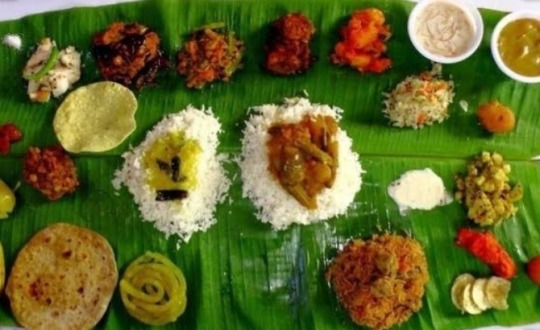
Hi Readers, welcome to indianfoodinusadotcom, Here you can learn all about Indian foods, recipes and all about INDIAN FOOD like {ABOUT INDIAN FOOD}
{HISTORY}
{VEDIC AGES}
{ANTIQUITY}
{FOOD MENTIONED IN ANECIENT INDIAN SCRIPTURE}
{MIDDLE AGE OF 16th CENTURY}
{COLONIAL PERIODS}
{INGREDIENTS}
{RECIPES}
LIKE (a) chicken Biryani (b) mutton biryani (c)Butter chicken (d) chicken tikka masala (e) veg biryani (f) Palak paneer (g) Matar paneer (h) chutneys, AND Many more.
ABOUT INDIAN FOOD in USA
You will get know more about the best restaurants Around the world
INDIAN FOOD consists of a variety of regional and traditional cuisines native to India. Given the diversity in soil, climate, culture, ethnic groups, and occupations, these cuisines vary substantially and use locally available spices, herbs, vegetables, and fruits.
Indian food is also heavily influenced by religion, in particular Hinduism and Islam, cultural choices.
Historical events such as invasions, trade relations, and colonialism have played a role in introducing certain foods to this country. The Columbian discovery of the New World brought a number of new vegetables and fruit to India. A number of these such as potatoes, tomatoes, chillies, peanuts, and guava have become staples in many regions of India.
INDIAN FOOD has shaped the history of international relations; the spice trade between India and Europe was the primary catalyst for Europe's Age of Discovery.
Spices were bought from India and traded around Europe and Asia. INDIAN FOOD has influenced other cuisines across the world, especially those from Europe (especially Britain), the Middle East, Southern African, East Africa, Southeast Asia, North America, Mauritius, Fiji, Oceania, and the Caribbean.
HISTORY OF INDIAN FOOD NON-VEGETARIAN
INDIAN FOOD reflects an 8,000-year history of various groups and cultures interacting with the Indian subcontinent, leading to a diversity of flavors and regional cuisines found in modern-day India. Later, trade with British and Portuguese influence added to the already diverse INDIAN FOOD.
After 9000 BCE, the first period of indirect contact between the Fertile Crescent and Indus Valley civilizations seems to have occurred due to the Neolithic Revolution and the diffusion of agriculture. Around 7000 BCE, agriculture spread from the Fertile Crescent to the Indus Valley, and wheat and barley began to be grown. Sesame and humped cattle were domesticated in the local farming communities.
Mehrgarh is one of South Asia's earliest sites with evidence of farming and herding. From circa 4500 to 1900 BC the rulers of Lower Mesopotamia were Sumerians who spoke a non-Indo-European and non-Semitic language, may have initially come from India and may have been related to the original Dravidian population of India.
By 3000 BCE, turmeric, cardamom, black pepper and mustard were harvested in India.
From Around 2350 BCE the evidence for imports from the Indus to Ur in Mesopotamia have been found, as well as Clove heads which are thought to originate from the Moluccas in Maritime Southeast Asia were found in a 2nd millennium BC site in Terqa. Akkadian Empire records mention timber, carnelian and ivory as being imported from Meluhha by Meluhhan ships, Meluhha being generally considered as the Mesopotamian name for the Indus Valley Civilization.
VEDIC AGE
VEGETARIAN
The ancient Hindu text Mahabharata mentions rice and vegetable cooked together, and the word "pulao" or "pallao" is used to refer to the dish in ancient Sanskrit works, such as Yājñavalkya Smṛti. Ayurveda, ancient Indian system of wellness, deals with holistic approach to the wellness, and it includes food, dhyana (meditation) and yoga.
ANTIQUITY
Early diet in India mainly consisted of legumes, vegetables, fruits, grains, dairy products, and honey.
Staple foods eaten today include a variety of lentils (dal), whole-wheat flour (aṭṭa), rice, and pearl millet (bājra), which has been cultivated in the Indian subcontinent since 6200 BCE.
Over time, segments of the population embraced vegetarianism during the Śramaṇa movement while an equitable climate permitted a variety of fruits, vegetables, and grains to be grown throughout the year.
A food classification system that categorised any item as saatvic, raajsic, or taamsic developed in Yoga tradition. The Bhagavad Gita proscribes certain dietary practices.
Consumption of beef is taboo, due to cows being considered sacred in Hinduism.[14] Beef is generally not eaten by Hindus in India except for Kerala, parts of southern Tamil Nadu and the north-east.
PICKLES
FOOD MENTIONED IN ANECIENT INDIAN SCRIPTURE
While many ancient Indian recipes have been lost in history, one can look at ancient texts to see what was eaten in ancient and pre-historic India.
Barley—(known as Yava in both Vedic and Classical Sanskrit) is mentioned many times in Rigveda and other Indian scriptures as one of the principal grains in ancient India
Betel leaf—primary use is as a wrapper for the chewing of areca nut or tobacco, where it is mainly used to add flavour; may also be used in cooking, usually raw, for its peppery taste
Breadfruit—fritters called jeev kadge phodi in Konkani or kadachakka varuthath in Malayalam are a local delicacy in coastal Karnataka and Kerala
Chickpeas—popular dishes are made with chickpea flour, such as mirchi bajji and mirapakaya bajji
Curd—a traditional yogurt or fermented milk product, originating from the Indian subcontinent, usually prepared from cow's milk, and sometimes buffalo milk, or goat milk
Figs —cultivated from Afghanistan to Portugal, also grown in Pithoragarh in the Kumaon hills of India; from the 15th century onwards, also grown in areas including Northern Europe and the New World
Ghee—a class of clarified butter that originated in ancient India, commonly used in the Indian subcontinent, Middle-Eastern cuisine, traditional medicine, and religious rituals
Grape wine —first-known mention of grape-based wines in India is from the late 4th-century BC writings of Chanakya
Honey —the spiritual and supposed therapeutic use of honey in ancient India was documented in both the Vedas and the Ayurveda texts
Mango—the Jain goddess Ambika is traditionally represented as sitting under a mango tree
Mustard —brown mustard is a spice that was cultivated in the Indus Valley civilization and is one of the important spices used in the Indian subcontinent today
Pomegranate—in some Hindu traditions, the pomegranate (Hindi: anār) symbolizes prosperity and fertility, and is associated with both Bhoomidevi (the earth goddess) and Lord Ganesha (the one fond of the many-seeded fruit)
Rice—cultivated in the Indian subcontinent from as early as 5,000 BC
Rice cake—quite a variety are available
Rose apple—mainly eaten as a fruit and also used to make pickles (chambakka achar)
Saffron —almost all saffron grows in a belt from Spain in the west to Kashmir in the east
Salt —considered to be a very auspicious substance in Hinduism and is used in particular religious ceremonies like house-warmings and weddings; in Jainism, devotees lay an offering of raw rice with a pinch of salt before a deity to signify their devotion, and salt is sprinkled on a person's cremated remains before the ashes are buried
Sesame oil —popular in Asia, especially in Korea, China, and the South Indian states of Karnataka, Andhra Pradesh, and Tamil Nadu, where its widespread use is similar to that of olive oil in the Mediterranean
Sorghum—commonly called jwaarie, jowar, jola, or jondhalaa, sorghum is one of the staple sources of nutrition
Sugar—produced in the Indian subcontinent since ancient times, its cultivation spread from there into modern-day Afghanistan through the Khyber Pass
Sugarcane—the earliest known production of crystalline sugar began in northern India; the earliest evidence of sugar production comes from ancient Sanskrit and Pali texts
Turmeric —used widely as a spice in South Asian and Middle Eastern cooking
Middle Ages to the 16th Century
VEG DUM BIRYANI
During the Middle Ages, several Indian dynasties were predominant, including the Gupta dynasty. Travel to India during this time introduced new cooking methods and products to the region, including tea.
India was later invaded by tribes from Central Asian cultures, which led to the emergence of Mughlai cuisine, a mix of Indian and Central Asian cuisine. Hallmarks include seasonings such as saffron.
Colonial Period
The Portuguese and British during their rule introduced cooking techniques such as baking, and foods from the New World and Europe.
The new-world vegetables popular in cuisine from the Indian subcontinent include tomato, potato, sweet potatoes, peanuts, squash, and chilli. Most New World vegetables such as sweet potatoes, potatoes, Amaranth, peanuts and cassava based Sago are allowed on Hindu fasting days. Cauliflower was introduced by the British in 1822. In the late 18th/early 19th century, an autobiography of a Scottish Robert Lindsay mentions a Sylheti man called Saeed Ullah cooking a curry for Lindsay's family. This is possibly the oldest record of INDIAN FOOD in the United Kingdom.
INGREDIENTS
Staple foods of INDIAN FOOD include pearl millet (bājra), rice, whole-wheat flour (aṭṭa), and a variety of lentils, such as masoor (most often red lentils), tuer (pigeon peas), urad (black gram), and moong (mung beans). Lentils may be used whole, dehusked—for example, dhuli moong or dhuli urad—or split. Split lentils, or dal, are used extensively, Some pulses, such as channa or cholae (chickpeas), rajma (kidney beans), and lobiya (black-eyed peas) are very common, especially in the northern regions. Channa and moong are also processed into flour (besan).
Many Indian dishes are cooked in vegetable oil, but peanut oil is popular in northern and western India, mustard oil in eastern India, and coconut oil along the western coast, especially in Kerala and parts of southern Tamil Nadu, Gingelly (sesame) oil is common in the south since it imparts a fragrant, nutty aroma.
In recent decades, sunflower, safflower, cottonseed, and soybean oils have become popular across India, Hydrogenated vegetable oil, known as Vanaspati ghee, is another popular cooking medium, Butter-based ghee, or deshi ghee, is used commonly.
Many types of meat are used for Indian cooking, but chicken and mutton tend to be the most commonly consumed meats. Fish and beef consumption are prevalent in some parts of India, but they are not widely consumed except for coastal areas, as well as the north east.
The most important and frequently used spices and flavourings in INDIAN FOOD are whole or powdered chilli pepper (mirch, introduced by the Portuguese from Mexico in the 16th century), black mustard seed (sarso), cardamom (elaichi), cumin (jeera), turmeric (haldi), asafoetida (hing), ginger (adrak), coriander (dhania), and garlic (lasoon).
One popular spice mix is garam masala, a powder that typically includes seven dried spices in a particular ratio, including black cardamom, cinnamon (dalchini), clove (laung), cumin (jeera), black peppercorns, coriander seeds and anise star.
Each culinary region has a distinctive garam masala blend—individual chefs may also have their own. Goda masala is a comparable, though sweet, spice mix popular in Maharashtra. Some leaves commonly used for flavouring include bay leaves (tejpat), coriander leaves, fenugreek (methi) leaves, and mint leaves. The use of curry leaves and roots for flavouring is typical of Gujarati and South INDIAN FOOD.
2 notes
·
View notes